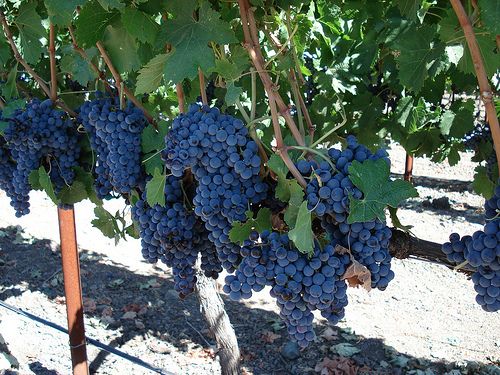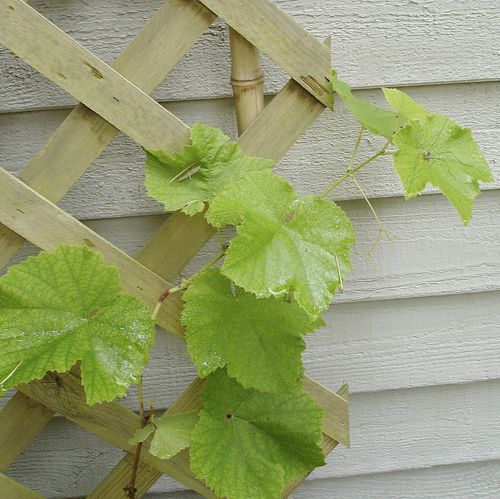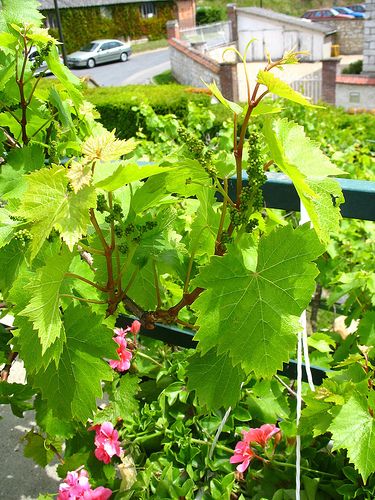
If you’re a grape fan, rest assured that you don’t need a formal vineyard to have a few vines planted in your home garden garden. In fact, grape vines are a perfect fit for a small garden, as well as traditional landscaping, especially if they’re under-planted with a ground-hugging annual or perennial. They’re easily trained against a wall and their bright leaves and handsome fruit will cover a cyclone fence beautifully. Large, deep containers also make an excellent home for grape vines.
November is the perfect time to discuss grapes because gardeners living in regions that have mild winters such as California would ideally plant their vines in the winter months. Those who get the deep snow will wait until we get a little closer to spring (about three weeks before their last frost date). Most gardeners purchase their vines as bare-root on year olds either at their local nursery or by mail order.
The best advice I have for choosing a variety that thrives in your area is to ask a local nursery or the Master Gardeners at the Cooperative Extension Office in your county. They can give you the best advice for your growing zone. There are three grape categories: European, American, and American Hybrids. American hybrids are crosses between American and European grapes. Most grape varieties are self-fruitful (they pollinate themselves), so a lone specimen grape vines is just fine, but they’re lovely plants and I have a hard time stopping at just one.
How to Plant Grapes
Grapes like to be situated in well-draining soil in the full sun. You’ll want to have a support of some kind such as a fence or arbor for the grape vines to grow against. Holes should be dug 1-1 1/2′ away from the support structure. The top growth on the plant (if there is any), should be cut it back so that it has 2 or three buds. Plant your vines about 8-10′ apart from each other.
Because you want the vines to lean slightly towards the support, position them at an angle and plant them as deep as they were in their original containers. Fair warning, depending on your climate, they may need to be planted a bit deeper to protect them in extreme cold, so check with a local authority. Before you place the plant into the hole, gently pull and straighten (or “tease”) the roots so that they’ll spread out inside the hole.
Grape leaves are prone to fungal diseases, it’s best to water them at the soil line as oppose to overhead — drip irrigation is your best bet. Grapes appreciate moderately fertile soil, so every so often an application of compost is nice, but they aren’t necessarily heavy feeders.
If you prune the old wood to two to three buds every year new growth will be stimulated, and fruit is produced on this new growth. Pruning will also restrict the plant’s size, which could be important in a small garden.
Popular Fresh-Eating Grape Varieties
Not being a wine drinker, far be it for me to tell you which grapes you’d be happy with for your wine-making. But here are some varieties that tast great eaten right off the vine.
- ‘America’ (American) — seedless, blue & rich flavor; resistant to Pierce’s disease
- ‘Price’ (American) — seedless, blue & sweet; good for cool areas
- ‘Himrod’ (American hybrid) — white, seedless, & spicy; vigorous plant
- ‘Reliance’ (American hybrid) — seedless, red, & sweet; productive plant
- ‘Thompson Seedless’ (European) — small, green, & sweet; best on hot & dry zones
- ‘Flame’ (European) — seedless & red; vigorous vines
- ‘Crimson Seedless’ (European) — large, seedless & red; flavorful grape





















Comments
Log in or create an account to post a comment.
Sign up Log in